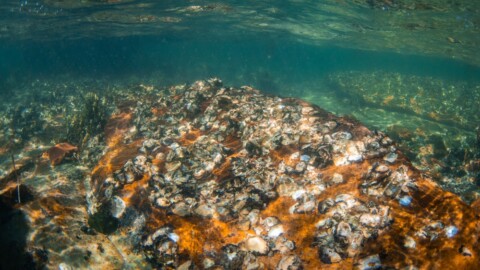by Professor Zhiguo Yuan AM, Director, Advanced Water Management Centre, The University of Queensland and Dr David De Haas, GHD
Wastewater handling contributes significantly to greenhouse gas (GHG) emissions. Many Australian water utilities have set the aspirational target of achieving GHG neutral operations. Such efforts should be applauded and incentivised by government policies, but unfortunately the current guidelines for GHG reporting do not give clear incentives for water utilities to reduce their direct (Scope 1) emissions.
Nitrous oxide and methane are potent greenhouse gases. Both are Scope 1 emissions associated with wastewater collection and treatment systems. As such, these gases typically make up an important part of a water utility’s total GHG emissions, but the actual emissions might not be accurately reported under existing reporting protocols.
In Australia, according to the National Greenhouse Gas Emission Reporting (NGER) technical guidelines, Scope 1 emissions from wastewater handling are calculated according to a series of formulae, which include a number of fixed emissions factors. For ease of reporting, we assume, these factors are part of a simplified approach in the methodology, but independent of the actual emissions.
Unfortunately, as a consequence, there is little or no reward for reduced direct emissions, despite it being achievable through process innovation and optimisation. In our view, overhaul of the technical guidelines is urgently required.
GHG emissions from wastewater handling
Broadly, in GHG reporting protocols worldwide, three so-called ‘scopes’ are defined. Scope 1 includes all direct emissions from a facility, such as combustion of fossil fuels, use of chemicals or formation of gases. Scope 2 covers the indirect emissions for a facility associated with electricity use from a state or territory electricity grid.
Scope 3 covers a range of activities associated with a facility that also generates indirect emissions, but for which reporting is voluntary. Scope 3 reporting is voluntary because the same emissions are expected to be reported as either Scopes 1 or 2 elsewhere in the economy.
Wastewater systems contribute to GHG emissions not only through their significant consumption of grid electricity (Scope 2) in most cases, but also through direct emissions of nitrous oxide (N2O) and methane (CH4). These are often called ‘fugitive’ gases because they escape from the collection and treatment systems.
CH4 emission: Wastewater contains organics, which can be biologically converted to CH4 in the absence of oxygen (i.e. under anaerobic conditions). In some parts of wastewater collection and treatment systems, anaerobic conditions prevail, leading to the formation of CH4 and its subsequent emission into the atmosphere.
N2O emission: Wastewater contains nitrogen, which needs to be removed to avoid nutrient enrichment of receiving waters. Biological nitrogen removal has been implemented at most large wastewater treatment plants in Australia. N2O is either an intermediate reaction or a by-product of the key biological reactions involved. Therefore, N2O is formed in, and could be emitted from, wastewater treatment plants.
The indirect (Scope 2) emissions are expected to decrease substantially in the coming decade, due to both the increased recovery of energy from wastewater (e.g. in the form of biogas from anaerobic digestion) and improved efficiency of electrical energy use for wastewater treatment.
Furthermore, the current trend is towards increasing renewable energy supply, with resultant lower Scope 2 emission factors. Therefore it is foreseeable that Scope 1 emissions might in future dominate the GHG profile of many wastewater treatment plants. Indeed, for some treatment plant in Australia, this may already be true.
NGER accounting guidelines for direct emissions
Under NGER technical guidelines, a mass balance approach is used to calculate the removal of organic material or nitrogen, as the sources of methane or nitrous oxide. Various emission factors are then applied to estimate CH4 and N2O emissions.
For theoretical methane (CH4) generation calculations, the emission factor applied is chosen from a limited list of options, broadly according to whether the treatment processes are predominantly aerobic or anaerobic. Actual treatment technologies are not considered in any level of detail.
Similarly, for nitrous oxide (N2O), no account is taken of the treatment process or technology applied. A single fixed emission factor is applied to nitrogen removal by the treatment process, regardless of process type or configuration. Actual nitrous oxide emission measurements are not taken into consideration.
Potential Scope 1 (notably methane) emissions from sewer collection systems are not included, under NGER guidelines.
According to the Federal Government’s Quarterly Update of Australia’s National Greenhouse Gas Inventory: September 2018 (NGGI), based on the NGER methodology, the waste sector (including wastewater handling) contributed 12.1 megatonnes CO2 per annum or 2.3 per cent of the national total for the 2018 financial year.
Of this, domestic and commercial wastewater handling contributed 3.5 megatonnes CO2 per annum (or around 0.7 per cent of the national total).
Under NGER guidelines for wastewater treatment plants, the Scope 1 emissions can range from 20 to 60 per cent of the total emissions reported, with the remaining balance being Scope 2 emissions associated with grid electricity use.
Very roughly, in the absence of more accurate information, an approximate split of one-third Scope 1 and two-thirds Scope 2 emissions might be assumed for a typical wastewater treatment plant. To reduce GHG emissions from wastewater handling, it is important to reduce both the direct (Scope 1) and indirect (Scope 2) emissions.
The reality
Understanding of greenhouse gas emissions related to wastewater handling has improved a lot in the last ten years, thanks to the efforts of researchers and the water industry, including significant contributions from Australia.
Direct field measurements have shown that N2O emissions from wastewater treatment processes vary substantially, from close to zero to over six per cent of the total nitrogen load to the treatment plant. Compared with the emission factor in the NGER (2016) guidelines, which is one per cent of total nitrogen removed, the actual N2O emissions might range from being negligible to values that are several times greater than the guideline value (Figure 1).
These studies also showed that N2O mitigation through process innovation and optimisation is achievable, often at little or no cost. Perversely, however, water utilities might receive no credit for reduced direct emissions due to the fixed emission factors applied in the calculations under the current NGER methodology.
Similarly, direct field measurements have shown that CH4 emissions from sewers are far from being negligible, contrary to the implicit assumption of no reportable emissions under the NGER methodology. CH4 emissions from sewers could potentially contribute up to 20-30 per cent of the total GHG emissions from wastewater handling.
Proposed solutions
Full-scale monitoring of N2O emissions from wastewater treatment plants have shown large variations, caused by different process designs, different operational conditions, as well as variations in wastewater flow and composition. This means N2O emissions from each plant should be quantified individually.
The quantification can be done through either direct measurements or mathematical modelling, and a combination of the two approaches.
As demonstrated in numerous studies reported in literature, N2O concentrations in the off-gas can be accurately measured using on-line N2O analysers. The concentration data, along with the gas flow rate data, measured or derived from compressed air consumption, allows the N2O emission fluxes to be calculated.
Alternative to gas-phase measurement, N2O emissions may also be estimated based on measurement of dissolved N2O residual concentration. A gas-liquid mass transfer model is needed in this case to convert the liquid-phase N2O data into N2O flux data.
Both of the above approaches require significant field measurements. A simpler and more pragmatic approach is to estimate N2O emissions using dynamic, biochemical models, which are able to predict, with good levels of confidence, dynamic N2O emissions during biological nitrogen conversions, based on plant design, operational conditions and wastewater flow and composition. The models can be tested and calibrated using direct N2O measurements.
It is not practical to measure CH4 emissions across an entire sewer network. However, mathematical models are available to predict CH4 emissions from sewers. In particular, steady-state equations have been proposed recently to predict CH4 emissions in both rising main and gravity sewers. These equations have already been applied to estimating CH4 emissions from large networks, in a relatively straightforward way.

FIGURE 1: COMPARISON OF NITROUS OXIDE (N2O) NGER EMISSION FACTOR AND ACTUAL N2O EMISSION FACTORS MEASURED FOR DIFFERENT PLANT CONFIGURATIONS (LITERATURE DATA).
Summary
Actual methane and nitrous oxide emissions associated with wastewater handling vary significantly, depending on the type of system and a range of operating factors.
Emissions can make up a substantial portion of Scope 1 GHG emissions reported as part of the total for water utilities that serve urban areas. The existing GHG reporting (NGER) system in Australia does not make provision for measurements or estimates of actual Scope 1 nitrous oxide and methane emissions from wastewater handling.
Without a change in the NGER guidelines, it will be essentially impossible for water utilities in Australia to claim credit for actual Scope 1 GHG emissions reductions of these gases, as part of a quest to achieve carbon reduction targets.















